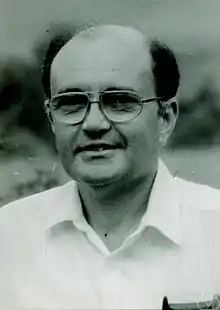Ronald Getoor
Ronald Kay Getoor (9 February 1929, Royal Oak, Michigan – 28 October 2017, La Jolla, San Diego, California)[2][3] was an American mathematician.

Ronald Kay Getoor | |
|---|---|
| Born | Ronald Kay Getoor 9 February 1929 |
| Died | October 28, 2017 (aged 88) |
| Nationality | |
| Alma mater | University of Michigan |
| Known for | Blumenthal-Getoor index |
| Scientific career | |
| Fields | Probability |
| Institutions | |
| Thesis | Some Connections Between Operators in Hilbert Space and Random Functions of Second Order[1] (1954) |
| Doctoral advisor | Arthur Herbert Copeland[1] |
| Doctoral students | |
Getoor received from the University of Michigan bachelor's degree in 1950, master's degree in 1951,[4] and Ph.D. in 1954 under Arthur Herbert Copeland with thesis Connections between operators in Hilbert space and random functions of second order.[5] As a postdoc he was an instructor at Princeton University. He became in 1956 an assistant professor and then full professor at the University of Washington. During the academic year 1964–1965 he was a visiting professor at Stanford University. From 1966 until his retirement in 2000 he was a professor at the University of California, San Diego.
Getoor's research deals with probability theory, especially the theory of Markov processes and potential theory. In 1970 he was an invited speaker at the International Congress of Mathematicians in Nice. He was elected a Fellow of the Institute of Mathematical Statistics and in 2012 a Fellow of the American Mathematical Society.
Scientific work
In the late 1950s, Getoor and Richard Blumenthal set out to understand the work of Gilbert Hunt on the connection between Markov processes and potential theory, extending the connections between Brownian motion and Newtonian potential theory. Getoor's book on 'Markov processes and potential theory', co-authored with Richard Blumenthal, became a reference on the topic.
Together with Blumenthal and Sharpe, Getoor obtained many results on the fine structure of Markov processes and martingales, in particular the theory of local time for Markov processes.
With Michael J. Sharpe, Getoor defined the notion of 'conformal martingale',[6] which proved to be influential in potential theory, investigated the behavior of Bessel processes, last-exit times and excursions. Starting in the early 1980s, Getoor studied stationary extensions of a given strong Markov process, with time extending to infinity in both directions, formulating a pathwise view of "time reversal" which became a key tool in his studies of the excessive measures of a Markov process.
The 'Blumenthal-Getoor index', a concept which characterises the nature of discontinuities of Lévy processes and semi-martingales, is named after him.
Personal life
He married in 1959. His wife Ann Getoor worked on the design of commercial aircraft at Boeing, and his daughter Lise Getoor is a professor of computer science at the University of Maryland. Ronald Kay Getoor died peacefully at home on October 28, 2017 in La Jolla at the age of 88.[3]
Books
- Markov processes: Ray processes and right processes. Lecture Notes in Mathematics 440. Springer Verlag. 1975. 2006 reprint; pbk, 124 pages
- with Robert McCallum Blumenthal: Markov Processes and Potential Theory. Academic Press. 1968.[7]
- Excessive Measures. Birkhäuser. 1990. 2012 reprint; pbk, 190 pages
Articles
- Blumenthal, R. M. (1959). "Some relationships involving subordination". Proc. Amer. Math. Soc. 10 (3): 502–510. doi:10.1090/S0002-9939-1959-0105744-3.
- with R. K. Getoor: Blumenthal, R. M.; Getoor, R. K. (1960). "Some theorems on stable processes". Trans. Amer. Math. Soc. 95 (2): 263–273. doi:10.1090/S0002-9947-1960-0119247-6.
- Blumenthal, R. M.; Getoor, R. K. (1961). "Sample functions of stochastic processes with stationary independent increments". Journal of Mathematics and Mechanics. 10 (3): 493–516. JSTOR 24900735.
- Blumenthal, R. M.; Getoor, R. K.; Ray, D. B. (1961). "On the distribution of first hits for the symmetric stable processes". Trans. Amer. Math. Soc. 99 (3): 540–554. doi:10.1090/S0002-9947-1961-0126885-4.
- Blumenthal, R. M.; Getoor, R. K. (1964). "Additive functionals of Markov processes in duality". Trans. Amer. Math. Soc. 112: 131–163. doi:10.1090/S0002-9947-1964-0160269-0.
- Blumenthal, R. M.; Getoor, R. K. (1964). "Local times for Markov processes". Zeitschrift für Wahrscheinlichkeitstheorie und Verwandte Gebiete. 3 (1): 50–74. doi:10.1007/BF00531683.
- Getoor, R.K.; Sharpe, M.J. (1972). "Conformal martingales". Inventiones Mathematicae. 16: 271–308. doi:10.1007/BF01425714.
References
- Ronald Getoor at the Mathematics Genealogy Project
- biographical information from American Men and Women of Science, Thomson Gale 2004
- "Ronald K. Getoor's Obituary on San Diego Union-Tribune". San Diego Union-Tribune. Retrieved 2017-11-27.
- UC San Diego Mathematics Profile, Ronald Getoor
- Ronald Getoor at the Mathematics Genealogy Project
- Getoor, R.K.; Sharpe, M.J. (1972). "Conformal martingales". Inventiones Mathematicae. 16: 271–308. doi:10.1007/BF01425714.
- Meyer, P. A. (1969). "Review: Markov processes and potential theory by R. M. Blumenthal and R. K. Getoor" (PDF). Bull. Amer. Math. Soc. 75 (5): 912–916. doi:10.1090/s0002-9904-1969-12282-2.
